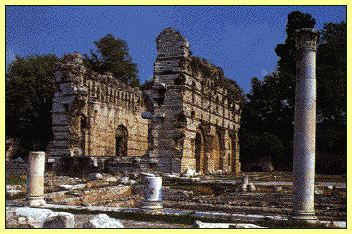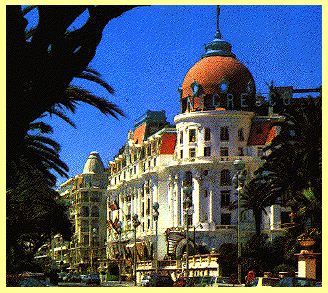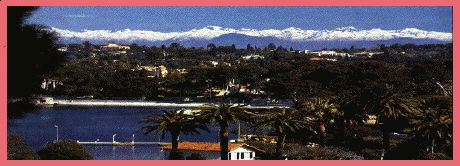
...improvised streets, ruins and jazz...
A way from the beach, and east of the Promenade des Anglais , is the old centre of town - Vieux Nice. You can almost touch the Italian influence - the place buzzes, it's lively and animated. There are lots of small, inexpensive restaurants and pizzerias.
Many people's favourite attraction is the cours Saleya . It's a marketplace, bursting with colour, where you'll find an abundance of flowers, a Niçois green sprout salad speciality known as mesclun , and the best of the local fish catches. (Look out for Stockfish on your restaurant's carte in the evening - you probably saw it in the market earlier in the day.)
There's activity all around. Watch out for the delivery boys arriving with hot socca . It's a chickpea crêpe which has been deep fried in a batter - almost as satisfying as the old town itself.
As you wander down its narrow Italianate streets , the Baroque churches compete with the hanging washing and chic snooker parlours. This is no informal grid of streets as found a little further west. Vieux Nice is small and perfectly formed. Take some time to linger with the locals at the Chapon Fin on rue Moulin and you'll soon find out for yourself.
Though Vieux Nice has its own special history, the oldest part of France's fifth largest city is Cimiez. Nowadays, it's a sophisticated, mainly residential area sitting on a hill where, many moons ago, the Romans settled.
They arrived in the first century BC, and by the third century AD, Cimiez had 20,000 residents, and was the capital of a small eastern Gaul province called Alpes Maritimae . (The name of the département - County or State - nowadays is Alpes Maritimes.)
As with the local names, some of the Roman influence lives on. During the third century AD, they built thermal baths and arenas in Cimiez. Despite the wear and tear of the centuries, the amphitheatre still manages to contribute to Nice's big music event of the year - the Nice Jazz Festival.
Each July, in and around the amphitheatre, there are several stages in action simultaneously। One ticket buys you entry to concerts throughout the day - and, despite the number of big names who turn up each year, the atmosphere is relaxed and easy going. After all, a sultry July evening is not the time to be rushing around - especially when there's the next day's concert to look forward to.
- the Promenade des Anglais -
L ined with cafes and hotels, both modern and Belle Epoque, museums and posh apartments, the Promenade des Anglais is a long wide road which runs the length of the seafront at Nice . You walk across it and you're on the beach beside an unbelievably blue mediterranean .

The actual promenade itself, begins at the eastern end of Nice by the Jardin Albert I and runs westward towards the airport - a long way.
The older and grander hotels of the Promenade des Anglais were built at the turn of the century. In most people's eyes, the grandest, with its Empire and Napoléon decor, is the Negresco.
The building, which is now a national monument, was built in 1912 by Henri Négresco, a Hungarian immigrant. Before he started the hotel, Henri was director of the city casino's restaurant - we're talking guests who were the richest people in the world, the Rockefellers and the Singers. He wanted his hotel to be a hauts lieux as well, and had it designed to attract the very top of the upper crust.
As bad luck would have it, World War I reared its ugly head, and the hotel became a hospital. Négresco died shortly after the war, a ruined man.
Once the Americans arrived during the roaring twenties business soon picked up. Especially once Gerald and Sara Murphy and their entourage of writers and celebrities had discovered the pleasures of summer on the Riviera.
There are many more pleasures to be discovered on and around the Promenade des Anglais. On the Avenue des Baumettes, there is the Musé des Beaux-Arts Jules. And, in a little park on Rue de france just off the promenade, there is the Musée Masséna named after a local boy who was made a Napoleonic general.
Weary? Take a short walk back to the beach and enjoy the view across the bay to the Cap d'Antibes and the fortified Port Vauban which was built to defend Antibes, and France, from the Niçois।
The Cap d'Antibes
Driving from the seafront at Juan les Pins the road winds its way towards the peninsular known as the Cap d'Antibes. For several kilometres this road meanders in an out following the contours of the coast line and skirts a number of quite lovely coves such as Mouton harbour, the Piton moorings and the Olivette harbour. Gradually the road narrows as it runs alongside the fortified watchtower of Grillon, built in the early eighteen-hundreds, which nowadays houses a small but very interesting museum of Napoleonic memorabilia.
A short distance from the museum is the famous Eden-Roc Hotel, often described as the most fabulous hotel in the world. . Everyone from the President of the Republic, to Arab princes, to stars of the stage and screen - all have stayed here in this security-conscious Shangri-La where credit cards are not recognised and hard cash is the only currency.
Close by - but not so close as to intrude on the Eden-Roc grounds is the Chines Verts Villa where Jules Verne stayed and wrote parts of his masterpieces.
A little further along, the road is bounded by high walls, beyond which cameras and other electronic devices oversee the entrances to magnificent villas standing in their own grounds, surrounded by luxuriant vegetation. Here and there can be glimpsed miniature harbours complete with cranes to haul speedboats and other craft out of the water.
Beyond Illette Point there is a lighthouse which towers over the tiny cove the locals call the "Faux-Argent". Summers visitors often argue as to whether the light emitted is silver, green or blue. Nearby and tucked away out of sight, as it were, behind the Bacon Point is a small but sandy beach known as Jonquet Cove, which affords a magnificent view of the entire coastline.
On the other side of the road a path leads up to the church of Saint Benoit and further up the hill to La Garoupe, which has its own lighthouse and signal station. This too affords a wonderful view of the coastline, this time almost from an eagle's perspective, which can the better be viewed by the aid of the telescopes installed for that purpose.
Here also is the ancient chapel of Notre Dame du Bon Port, founded in the fifth century by the monks of Lèrins. It was built on the site of a pagan sanctuary dedicated to the moon goddess Selena. An unusual aspect of this chapel is that it has two naves, one built in the 13th century and the other a hundred years later.
Visitors here are astonished to find that on one side of the altarpiece is a 14th century Russo-Byzantine icon and on the other side a superb piece of painted silk dating from the Middle Ages. There is also a cross brought back from the Siege of Sebastopol and two gilded statues portraying "Our Lady who Guards" and "Our Lady of Safe Return". This latter is honoured every July by the sailors of Antibes . The rear and side walls of the chapel are covered with a collection of personal messages to the Virgin, some are of thanks, some are an entreaty. One poignant message is: a baby's sock is pinned to the wall with a message imploring the Virgin to care for the soul of its former owner.
Somewhat further down the hill and toward the middle of the peninsular is the Chateau Thénard where the Grand-Duke Nikolai lived the latter part of his life. However he may have lived in his native Russia, before he died in 1924 he surely never could have complained at being exiled to this veritable paradise.



No comments:
Post a Comment